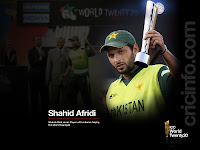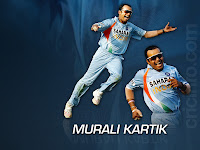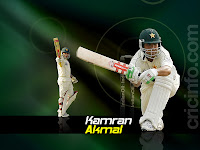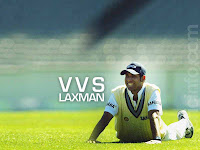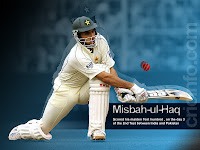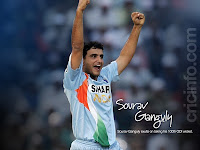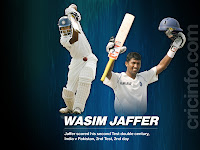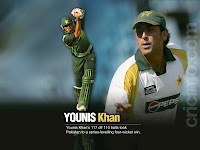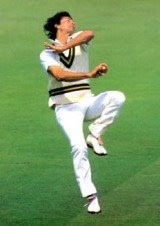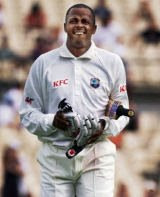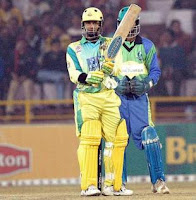 The Pakistan Cricket Board has banned players who participated in the unofficial Indian Cricket League (ICL) from playing in the ongoing domestic season. Six Pakistan players - Inzamam-ul-Haq, Azhar Mahmood, Abdul Razzaq, Shabbir Ahmed, Imran Farhat and Taufiq Umar - appeared in the inaugural tournament of the ICL earlier this month.
The Pakistan Cricket Board has banned players who participated in the unofficial Indian Cricket League (ICL) from playing in the ongoing domestic season. Six Pakistan players - Inzamam-ul-Haq, Azhar Mahmood, Abdul Razzaq, Shabbir Ahmed, Imran Farhat and Taufiq Umar - appeared in the inaugural tournament of the ICL earlier this month.
"It is a policy decision that players who play in unauthorised leagues cannot be allowed to play in any domestic competition organised by the PCB," said Shafiq Ahmed, the PCB domestic cricket general manager. "We cannot allow violation of our rules and regulations by anyone. We don't think it is a harsh decision."
Reacting to the ban, Farhat told Reuters, "Cricket is our bread and butter. This is a violation of our fundamental rights." He said the players would take legal action and try to obtain a stay on the ban.
The PCB had already announced that players associating with the ICL would not be considered for national selection.
On Saturday, the Indian board had stated its displeasure with Daryl Tuffey, the New Zealand fast bowler and an ICL recruit, being allowed to represent his state side Auckland in a 50-over match against the visiting Bangladesh side.
Monday, December 24, 2007
Domestic ban for Pakistan's ICL players
Posted by
Faizan Rasool
at
2:42 PM
![]()
![]()
Friday, December 7, 2007
Fast bowlers, Kerry Packer, and the power of role models
I have an alternative theory: the power of the role model. In the early years Pakistan enjoyed the luxury of higher quality swing and seam bowling than might have been expected of the fledglings of world cricket. You couldn’t, however, have called them express pacemen. Sarfraz Nawaz, the godfather of reverse swing—and probably much else besides—was nothing more than fast medium from an enormous crazy-horse run. His rookie partner was a medium pace inswing bowler, Imran Khan.
When Imran and the other glitterati of Pakistan cricket joined Kerry Packer’s circus, they mixed with the game’s best and fastest bowlers. Clearly Imran was highly self-motivated and focused, but the Packer experience helped him understand the standard he and his country had to reach to compete at international level.
Post Packer, Imran became a true role model as fast bowler, captain, and glamour boy. Without him would we have had Wasim Akram and Waqar Younis? Probably yes, but in the way they developed, probably not. Without Imran, Wasim and Waqar would we have Shoaib Akhtar and Mohammad Asif? I guess not. It is interesting how many Indian fast bowlers also point to Wasim, in particular, as a role model.
All of which leads me to a troublesome conclusion. If you accept my hypothesis about the power of role model, what example are Shoaib and Asif setting? Shoaib’s unprofessional attitude has become legend, and an intermittent maestro is an unsatisfactory role model. Both of them have been tainted by the drugs scandal. Under a new captain, coach, and reprieve from the Court of Arbitration for Sport, Pakistan cricket has the look of somebody who has cheated the electric chair: bewildered euphoria.
Shoaib and Asif must now become role models who will inspire their team but also the future fast bowlers of Pakistan, a serious responsibility. We will now discover if they are capable of greatness like the role models who went before them.
Posted by
Faizan Rasool
at
1:57 PM
![]()
![]()
History of English cricket
History of English cricket to 1696...
This is a history of cricket from its origins up to the time when it became a major English sport towards the end of the 17th century.Cricket's origin is a mystery. All that can be said with a fair degree of certainty is that the game's beginning was earlier than 1550, somewhere within the counties of Kent, Sussex and Surrey, and most probably in the region known as the Weald. Unlike other games with batsmen, bowlers and fielders, such as stoolball and rounders, cricket can only be played on relatively short grass, especially as at this period the ball was delivered along the ground. Thus clearings in the forest where sheep had grazed might have been suitable places to play.
The sparse information available about the earliest days suggests that up until the early 1600s cricket was a children's game. Then it was taken up by working men. From roughly the time of the Restoration (1660), the gentry began to take an increasing interest, as patrons and occasionally as players. A big attraction for them was the opportunity that the game offered for gambling.
Chronology: 1300 - 1696
A number of cricket books make reference to incidents in the distant past before the game became properly organised and promoted during the 18th century. As far as is known, there is no comprehensive chronology of those events and the purpose here has been to create one. Starting with the tentative reference to creag in the days of Edward Longshanks, this is a collation of all known references until the mists of time began to clear around the beginning of the 18th Century and cricket matters began to be reported with increasing frequency and more detail in the English press.1300
Thurs 10 March (Julian). Wardrobe accounts of Edward I include a reference to a game called creag being played at the town of Newenden in Kent by Prince Edward (the future Prince of Wales), then aged 15. It has been suggested that creag was an early form of cricket. There is no evidence to support this view and creag could have been something quite different, but it does at least seem a likely suspect, especially when the location is considered.
The most widely accepted theory on the origin of cricket is that it developed among the farming and metalworking communities of the Weald, which spreads across Kent and Sussex. It is significant that these counties and neighbouring Surrey were the earliest centres of excellence and that it was from there that the game eventually reached London, where it achieved mass popularity, and Hampshire, where it achieved both fame and legend.
It is quite likely that cricket was devised by children and survived for many generations as essentially a children’s game. Possibly it was derived from bowls, assuming bowls is the older sport, by the intervention of a batsman trying to stop the ball reaching its target by hitting it away. Playing on sheep-grazed land or in clearings, the original implements may have been a matted lump of sheep’s wool (or even a stone or a small lump of wood) as the ball; a stick or a crook or another farm tool as the bat; and a gate (e.g., a wicket gate), a stool or a tree stump as the wicket. The invention of the game could have happened in Norman or Plantagenet times anytime before 1300; or even in Saxon times before 1066.
There is a theory about the development of the game’s name which suggests that creag evolved into creag-a-wicket and then into the rhyming cricket-a-wicket, but this must have been much later and is in any case speculation. It seems more likely that the name derived from words that were in use, probably imported, after the Norman Conquest in 1066. In old French, the word criquet (which may have been confused with etiquet) seems to have meant a kind of club or stick; and it might have given its name to croquet. Some believe that cricket and croquet have a common origin but there is no evidence to substantiate that view. In Flemish, krick(-e) meant a stick and, in Olde English, cricc or cryce meant a crutch or staff.
- 1337
Edward III claimed the throne of France and so began a long series of conflicts that is collectively known as the Hundred Years War, which did not end until the English were finally expelled from most of France (i.e., except Calais) in 1453.
Some tentative cricket references have been found which suggest an apparent “French Connection” in the origins of cricket, such as one at St Omer in 1478 (see below). There is a key historical point here. As the Hundred Years War progressed, large parts of France including great cities like Paris and Bordeaux were subject to long-term English occupation. Paris, when François Villon was born there in 1431, was described as “an English town”. Calais remained an English possession until 1558, a whole century after the end of the Hundred Years War. So there may well be cricket references in France but they do not indicate a movement of the sport from France to England; they indicate that English soldiers and settlers brought their culture with them across the Channel during the long period of occupation.
- 1477
A statute of King Edward IV banned certain games, including one called handyn and handoute, on the grounds that they distracted his subjects from their compulsory practice of archery. There is no evidence to suggest that handyn and handoute was a form of cricket, as some have surmised. It was probably a simple indoor gambling game.
- 1478
A spurious reference to criquet near St Omer in Flanders, then part of the Duchy of Burgundy, seems to be a misreading of the word etiquet meaning a small stick. See explanation in HMM.
- 1523
Reference to stoolball found (see Bowen) re a designated field in Oxfordshire. This may be a generic term for any game in which a ball is somehow hit; or it may be a specific reference to an early form of rounders. 18th Century references to stoolball in conjunction with cricket clearly indicate that it was a separate activity. (See the references in TJM, paragraphs 98, 361 and 377.)
- 1550
Evidence in a 1597 court case indicates that kreckett was played on a certain plot of land in Guildford around 1550. This is the earliest reference to cricket being played in Surrey.
- 1597
Mon 17 January. The court case in Guildford concerned a dispute over a school's ownership of the plot of land in question. A 59-year old coroner, John Derrick, testified that he and his school friends had played kreckett on the site fifty years earlier. This is generally considered to be the first definite mention of cricket in the English language. The school was the Royal Grammar School, Guildford, and Mr. Derrick's account proves beyond reasonable doubt that the game was being played c.1550.
John Eddowes in his The Language of Cricket (1997) points out that Mr Derrick’s surname was derived from the Flemish name Hendrik. In Rowland Bowen’s history, he mentions that Heiner Gillmeister of Bonn University, a European language expert, derived “cricket” from the Flemish met de (krik ket)sen (i.e., "with the stick chase"), which may indicate a possible Flemish connection in the game’s origin, but it is more likely that the terminology of cricket was based on words in use in south east England at the time and, given trade connections with Flanders, especially in the 15th century when it belonged to the Duchy of Burgundy, many Flemish words will have found their way into southern English dialect.
- 1598
There was a reference to cricket in an Italian-English dictionary produced in 1598 by Giovanni Florio and his definition of the word sgillare, which he defines as: “to make a noise as a cricket, to play cricket-a-wicket, and be merry”. Some writers think the reference is spurious and relates only to the insect variety of cricket but “to play cricket-a-wicket” hardly suggests insect activity. Given the reference to cricket as a boys’ game in another dictionary only 13 years later, it would seem that Florio does have both an insect and a game in mind.
- 1610
First definite mention of cricket in Kent concerned a match at Chevening between teams from the "Weald" and the "Downs".
- 1611
First definite mention of cricket in Sussex relates to ecclesiastical court records which state that two parishioners of Sidlesham in West Sussex failed to attend church on Easter Sunday because they were playing cricket. They were fined 12d each and made to do penance.
A French-English dictionary was published by Randle Cotgrave. The noun crosse is defined as the crooked staff wherewith boys play at cricket. The verb form of the word is crosser, defined as to play at cricket.
It is interesting that cricket was defined as a boys’ game in the dictionary, as per the Guildford schoolboys of the 16th Century, but that adults were playing it in Sussex at the beginning of the 17th Century. It almost seems as if Mr Cotgrave was "overtaken by events" here. No sooner did he publish his dictionary than his definition was updated by the involvement of adults in cricket.
- 1613
A court case recorded that someone was assaulted with a cricket staffe at Wanborough, near Guildford.
- 1622
Several parishioners of Boxgrove, near Chichester in west Sussex, were prosecuted for playing cricket in a churchyard on Sunday 5 May.
There were three reasons for the prosecution: one was that it contravened a local bye-law; another reflected concern about church windows which may or may not have been broken; the third was that a little childe had like to have her braines beaten out with a cricket batt! This latter situation was because the rules at the time allowed the batsman to hit the ball twice and so fielding near the batsman was very hazardous, as two later incidents drastically confirm.
This is the earliest reference to the cricket bat. The use of a “batt” in cricket was peculiar to Kent and Sussex where coastal smugglers were known as batmen, because of the cudgels they carried. The earliest reference to a “flat-faced” bat (i.e., with a flat surface at the bottom of the stick in ice hockey style) also occurs in 1622 in the files of the Sussex Records Society (see Terry, note 23).
The term “bat” remained comparatively rare until about 1720. The terms in more general use were “staff”, “stave” or “stick”. These tended to have regional usage: for example, “stave” was used in the Gloucester area and “batt” in the south-east; while “staff” and especially “stick” were more widely used. “Bat” is derived from the French battledore, shaped like a table tennis bat, which was used by washerwomen to beat their washing with! (See OED re “battledore”).
- 1624
A fatality occurred at Horsted Keynes in east Sussex when a fielder called Jasper Vinall was struck on the head by the batsman who was trying to hit the ball a second time to avoid being caught. Mr. Vinall is thus the earliest recorded cricketing fatality. The matter was recorded in a coroner’s court, which returned a verdict of misadventure.
An interesting point arising from the court record is that both Jasper Vinall and the batsman Edward Tye came from West Hoathly, another village, which indicates that games involving teams from different villages were already being played.
- 1628
An ecclesiastical case is preserved that relates to a game at East Lavant, near Chichester in western Sussex, being played on a Sunday. One of the defendants argued that he had not played during evening prayer time but only before and after. It did him no good as he was fined the statutory 12d and ordered to do penance. Doing penance involved confessing his guilt to the whole East Lavant congregation the following Sunday.
- 1629
Henry Cuffin, a curate at Ruckinge in Kent, was prosecuted by an Archdeacon’s Court for playing cricket on Sunday evening after prayers. He claimed that several of his fellow players were persons of repute and fashion. This may indicate that cricket had achieved popularity among the well-to-do.
- 1636
In a court case concerning a tithe dispute, a witness called Henry Mabbinck testified that he played cricket in the Parke at West Horsley in Surrey.
- 1637
Another ecclesiastical case records parishioners of Midhurst, west Sussex, playing cricket during evening prayer on Sunday 26 February.
- 1640
Puritan clerics, at Maidstone and at Harbledown near Canterbury, denounced cricket as profane, especially if played on Sunday.
The influence of Puritans at this time is significant as this was the year in which the Long Parliament was first assembled and proved to be a precursor to the English Civil War.
- 1642
The English Civil War began and Parliament banned theatres, which had met with Puritan disapproval. Although similar action would be taken against certain sports, it is not clear if cricket was in any way prohibited, except that players must not break the Sabbath. References to the game during the Cromwell years suggest that it was not widely banned.
The preceding references indicate that inter-parish matches were being played but there is nothing to suggest that any teams representative of counties had been formed by this time. There is no evidence of large scale gambling or patronage prior to the English Civil War and it was those factors which drove the formation of "representative" teams in the 18th Century. It must be concluded, therefore, that the level of cricket being played before the war was still "minor" standard: inter-parish at best.
- 1646
The earliest record of an organised match is held in the report of a court case. The match took place at Coxheath in Kent on 29 May. The case concerned non-payment of a wager that was made at the game. Curiously, the wager was for twelve candles! The participants included members of the local gentry: further evidence of the sport’s growing affluence.
- 1647
A Latin poem contains a probable reference to cricket being played at Winchester College, earliest known mention of cricket in Hampshire.
A fatality was recorded at Selsey, west Sussex, when a player called Henry Brand was hit on the head by the batsman trying to hit the ball a second time. The case was obviously a repeat of the Horsted Keynes incident in 1624.
- 1652
A case at Cranbrook against John Rabson, Esq. and others refers to a certain unlawful game called cricket. It is interesting that the game was described as unlawful and that Rabson was evidently a gentleman whereas the other defendants were all working class. Cricket has long been recognised as the sport that bridged the class divide.
European colonisation of southern Africa began when the Dutch East India Company established a settlement called the Cape Colony on Table Bay, near present-day Cape Town. There was no significant British interest in South Africa until the Napoleonic Wars, when the Netherlands fell to Bonaparte and the British decided to secure the colony against French encroachment. The whole territory was formally ceded to Great Britain in 1814 by the Anglo-Dutch Treaty and administered as Cape Colony until it joined the Union of South Africa in 1910.
Cricket arrived very quickly once the British had finally taken over with the earliest known reference to the game in South Africa dated 1808.
- 1653
Some sports evidently were approved by the Puritans as Izaak Walton published [[The Compleat Angler]].
- 1654
Three men were prosecuted at Eltham in Kent for playing cricket on Sunday. As the Puritans were now firmly in power, Cromwell’s Protectorate having been established the previous year, the penalty was doubled to 24d (two shillings).
- 1656
The defendants in the 1654 case were charged with breaking the Sabbath, not with playing cricket. Cromwell’s commissioners in Ireland did ban sport in 1656 but not cricket. They were concerned as always with preventing unlawful assemblies in Ireland and sport was held to be that. The sport in question was hurling. Cricket had probably not reached Ireland at this time.
- 1658
The cricket ball was first referred to in those terms in a book by Edward Phillips.
- 1660
The Restoration of the monarchy in England was immediately followed by the reopening of the theatres and so any sanctions that had been imposed by the Puritans on cricket would also have been lifted. Although there are only a few references to the game in the time of Charles II, it is clear that its popularity was increasing and that it was expanding.
The Restoration was effectively completed during the spring of 1660 and it can safely be assumed that, in the general euphoria which both accompanied and followed these historic events, gambling on cricket and other sports was freely pursued. It is logical to assume that the large amounts at stake will have led some investors to try and improve their chances of winning by forming teams that were stronger than your typical parish XI. Although details continue to be conspicuous by their absence, there can be little doubt that the first teams representing several parishes and even whole counties were formed at this time; and so it may reasonably be concluded that this period saw the first great matches or major matches or important matches or whatever term may be applied to denote the highest level of cricket.
Indeed, it must be so that this was the historical point of origin of first-class cricket.
- 1662
The Printing Act was passed and introduced very stringent controls of the press. Sport, including cricket, was certainly not a subject to be reported.
- 1664
A Gambling Act was passed by the Cavalier Parliament to try and curb some of the post-Restoration excesses. It limited stakes to £100 which was in any case a fortune at the time. We know that cricket could attract stakes of 50 guineas by 1697 and it was funded by gambling throughout the next century.
- 1666
A letter by Sir Robert Paston of Richmond refers to a game on Richmond Green, which became a noted venue in the 18th century.
- 1668
The promoter of a match at Maidstone had to obtain a licence to sell ale there.
Cricket was again mentioned in a court case as being played at Shoreham in Kent.
It has been reported in some books that the Clerkenwell Rate Book rated the landlord of the Ram Inn, Smithfield, Middlesex for a cricket field but later investigation established the meaning was otherwise and that this was not a cricket reference.
- 1671
Perhaps a sign that the times, post-Restoration, they were a-changing. A man called Edward Bound was charged with playing cricket on the Sabbath and was exonerated! The case was reported in Shere, Surrey.
- 1676
Sat 6 May. A diarist called Henry Tonge, who was part of a British mission at Aleppo in Turkey (now in Syria), recorded that at least forty of the English left the city for recreational purposes and, having found a nice place to pitch a tent for dinner, they had several pastimes and sports including krickett. At six they returned home in good order.
- 1677
Accounts of Thomas Dacre, the Earl of Sussex, include an item which refers to £3 being paid to him when he went to a cricket match being played at ye Dicker, which was a common near Herstmonceux in east Sussex.
- 1678
Mention of cricket as a play (presumably in the sense of a sport that is played) in a Latin dictionary published by Dr Adam Littleton.
- 1680
Lines written in an old bible invite All you that do delight in Cricket, come to Marden, pitch your wickets. Marden is in west Sussex, north of Chichester, and interestingly close to Hambledon, which is just across the county boundary in Hampshire.
This is the earliest known reference to the wicket.
As is well known, the wicket until the 1770s comprised two stumps and a single bail. By that time, the shape of the wicket was high and narrow after the 1744 Laws of Cricket defined the dimensions as 22 inches high and six inches wide. But earlier 18th century pictures show a wicket that was low and broad, perhaps two feet wide by one foot high. The ends of the stumps were forked to support the light bail and there were criteria for the firmness of pitching the stumps into the ground and for the delicate placing of the bail so that it would easily topple when a stump was hit.
There has been a lot of conjecture about the origin of the wicket, but suffice to say that the 17th century outline shape is more akin to the profile of a church stool, which is low and broad. Furthermore, the legs of the stool were called stumps, which adds further credence to the idea that stools were used as early wickets. Interestingly, according to the Churchwarden’s Accounts for Great St. Mary’s Church of Cambridge (1504 – 1635), a church stool was sometimes known in the south-east by the Flemish name of “kreckett”, this being the same word used for the game by John Derrick in 1597.
- 1685
Mitcham Cricket Club is formed, with the club playing their cricket on what is today known as Mitcham Cricket Green. The site has hosted cricket matches ever since.
- 1693
A match in Sussex was the occasion of crowd trouble and a number of persons were charged with riot and battery. We know about it because of a later petition by the defendants to Queen Anne (who did not succeed until 1702) in which they pleaded for remission of fines imposed, they having been mere spectators at the game.
- 1694
Accounts of Sir John Pelham record 2s 6d paid for a wager concerning a cricket match at Lewes.
- 1695
Parliament decided against a renewal of the Licensing Act and so cleared the way for a free press on the Act’s expiry in 1696.
- 1696
Freedom of the press resulted from the British government's decision not to renew the Licensing Act. Censorship had already been relaxed following the Bill of Rights in 1689. It was from this time that cricket matters could be reported in the newspapers, but it would be a very long time before the newspaper industry adapted sufficiently to provide frequent, let alone comprehensive, reports.
By the end of the 17th Century, cricket had long since broken its bounds as a village pastime and was already into the age of great matches. All that was needed now was for the matches to be reported. The first "great match" we know of took place in Sussex in 1697...
Posted by
Faizan Rasool
at
1:26 PM
![]()
![]()
Tuesday, December 4, 2007
Kirsten signs deal to coach India
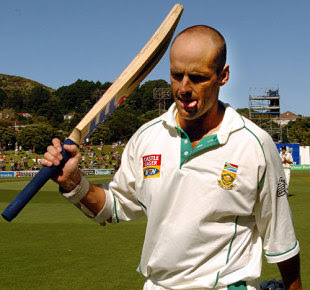 Gary Kirsten has signed a two-year deal to coach the Indian national team. He will start work on March 1, 2008, almost a year after his predecessor, Greg Chappell, resigned from the post.
Gary Kirsten has signed a two-year deal to coach the Indian national team. He will start work on March 1, 2008, almost a year after his predecessor, Greg Chappell, resigned from the post.
Kirsten signed the contract after clarifying a few last minute details pertaining to his young family and also to the feelings of senior players in the team who had been anonymously quoted as saying that the appointment of a coach was "unnecessary."
Sharad Pawar, the Indian board president, told Kirsten on Tuesday afternoon that all the senior players were looking forward to having him on board and agreed with Kirsten's suggestion that he meets up with the team before they depart for Australia.
Posted by
Faizan Rasool
at
1:59 PM
![]()
![]()
Monday, December 3, 2007
Murali breaks Warne's record
Murali achieved the record in his 116th Test and on his home ground.
Posted by
Faizan Rasool
at
4:57 PM
![]()
![]()
Monday, November 12, 2007
History of Test Cricket
The first Official Laws of Cricket were implemented in February 1774 when a group of gentlemen and nobles met at the Star and Garter in Pall Mall to formally lay down a set of Laws that would be followed by every cricketer, team and official in England. The first test match was played between England and Australia in 1877, with the creation of the famous "Ashes" trophy in 1882 after Australia easily beat the Marylebone Cricket Club team. The maximum individual test innings was completed on 13 April 2004, when Brian Lara of the West Indies scored 400 not out against England in Antigua, exceeding the previous record of 380 runs made by Matthew Hayden from Australia in a match against Zimbabwe in October 2003.
Posted by
Faizan Rasool
at
2:43 PM
![]()
![]()
Cricket Test Matches
Cricket test matches are the longest form of the sport of cricket and are considered by players and serious cricket fans. Playing an ultimate test match as compared to the one day international cricket is much more challenging and difficult. Test matches are played between national representative teams selected from the best players within a particular nation.
Code of Conduct for Cricket Test Match
Cricket test match is played over a span of five days with three sessions of two hours interspersed with a 40-minute break for lunch and 20-minute break for afternoon tea everyday. The team who wins the toss of the coin selects whether to bat or bowl first, and bats either until each batter is dismissed or they choose to stop batting, called a "declaration". There is no limit to how long they can bat provided there remain at least two batsman who have not been dismissed. After this the teams change roles, and the other team does the batting. If the other team is dismissed with a score 200 runs or more behind the first team, then the first team has the choice whether to make the other team bat again for their "second innings" or bat itself to gain a bigger lead.
If the follow-on is enforced, then the first team bats until it is dismissed or declares. If this team’s total score from both its innings is less than the other team, then it wins the game. If this is not the case then the other team must bat in its second innings to attempt to score more than the first team. If it is dismissed before this occurs, then the first team wins the game. If time runs out before either of the above occurs, the game is called a draw. If the follow-on is not enforced or the other team’s score is sufficiently large so that the follow-on cannot be enforced, once this team is dismissed or declares, then the first team bats again until it is dismissed or declares, or time runs out. If the score of the first team is less for its two innings as compared to the other team score from its innings, then the other team is the winner. Otherwise the other team will bat again. If their total score gets to more than the first team’s total, they win the match. If they are dismissed before reaching first team’s total, then first team wins the match. If neither occurs before the scheduled end of the match, it is a draw. At the end if both teams end up being dismissed twice with the same combined totals, the game is a tie.
Posted by
Faizan Rasool
at
2:42 PM
![]()
![]()
One Day Cricket Matches
One-day cricket matches is a form of cricket that is completed in a single day. It is different from Test and domestic first class cricket that often takes up to five days to complete or get the desired result. One-day cricket matches always ends with a result in a single days play.
In a one-day cricket match, each team bats only once and the innings are limited to a set number of overs, generally fifty. There can be some variations due to poor weather conditions. Other changes to the game include additional restrictions on where fielders may be placed and stricter rules on wide balls and short deliveries.In most matches, a white ball is used rather than the traditional red and as a result, the need to paint rather than stain the white ball gives it subtly different characteristics in flight as it wears. The white ball is generally restricted to matches played during the afternoon and into the evening, such matches are also known as day-night matches. The day and night matches necessitate the team batting second to begin their innings under stadium lights as a result of the lack of available natural sunlight.
The dress for one-day cricket matches is generally in bright colors clothing that adds to the spectators interest and also enhances the appeal for television viewers. One-day cricket originally began between English County teams in the 1960's. The first one-day international was played in Melbourne, Australia, in 1971. One day cricket matches are much more popular as compared to test matches as it encourages aggressive, risky and entertaining batting. One more reason for its popularity is that a spectator can go and see an entire match without the attendance of continuous five days.
Posted by
Faizan Rasool
at
2:35 PM
![]()
![]()
2003 Cricket World Cup
Australia, the winners of 1999 Cricket World Cup, had now emerged tall over the other cowering teams. Its supremacy remained to be challenged. The 2003 Cricket World Cup in South Africa Zimbabwe and Kenya provided an ideal arena for a pitched battle. Most teams like India, England and Pakistan had young, confident teams, though many doubted if their prowess were enough to outdo the mighty Aussies.
There were 14 teams contesting in the 2003 Cricket World Cup in South Africa, Zimbabwe and Kenya.
The teams were :
Australia · India · Pakistan · England · South Africa · Sri Lanka · West Indies · New Zealand · Kenya · Zimbabwe · Canada · Bangladesh · Namibia · Netherlands
The inclusion of teams like Netherlands and Canada was a part of the desperate strategies of the ICC to disseminate the popularity of cricket beyond the few test-playing nations. The format followed was super-six, same as the previous world cup in 1999. The teams were divided into two pools; Australia topped the Pool A while Sri Lanka dominated Pool B. The semi finals were held between Australia and Sri Lanka, and between India and Kenya. The 2003 Cricket World Cup in South Africa, Zimbabwe and Kenya proved lucky for one of the host nations, Kenya. It became the only non-test playing nation to reach the finals of the Cricket World Cup.The final proved to be a big disappointment for the thousands of Indian fans who had cut across the oceans to support their team. India lost tamely against the 2nd time winner Australia. The only consolation for them came in the form of Player of the Tournament award for Sachin Tendulkar.
Posted by
Faizan Rasool
at
12:30 PM
![]()
![]()
1999 Cricket World Cup
1999 World Cup in England brought with it the old world charms of the game, chiefly because it was being held in the place where cricket first took birth. The much anticipated final at the historical Lords was a reason enough to cause considerable excitement. 1999 World Cup provided a complete counterpoint to the1996 World Cup. Held in the subcontinent, 1996 World Cup encountered colorfully dressed spectators who danced and screamed and hurled both shouts and bottles at the players. The spectators in England know that the game they are watching is intrinsically linked to their tradition, consequently, apart from few sporadic scatterings of youth who have fun anywhere, the spectators in England bear a subdued appearance.
There were 12 teams competing for the coveted cup. Apart from the minnows Zimbabwe, Kenya, Bangladesh and Scotland, every one knew that each of the other 8 teams stood a fair chance in lifting the cup.
The twelve teams participating in 1999 Cricket World Cup were:
The preceding Cricket World Cups had seen many new formats being introduced and cast out with equal alacrity: in 1999 World Cup too, a new format called super six was introduced. The tournament progressed smoothly producing some brilliant contests like the semi final between Australia and South Africa. Though the scores were tied, Australia was declared the winner for having beaten South Africa before in the Super-Six round. For the first time since its inception, England failed to make it to the World Cup finals- a shameful debacle in front of the cheering home team. The final of the 1999 Cricket World Cup in England was held between Australia and Pakistan. The former trounced the 1992 winner in a one-sided match, winning by 8 wickets.
Posted by
Faizan Rasool
at
12:28 PM
![]()
![]()
1996 Cricket World Cup
The 1996 Cricket World Cup in India Pakistan and Sri Lanka was entwined in controversy and saw a lot of action-both on and off field. Sri Lanka won the tournament by emphatically beating Australia in the finals. The 1996 Cricket World Cup in India Pakistan and Sri Lanka had 12 participating nations. Netherlands, Kenya and the United Arab Emirates (UAE), were participating for the first time in a Cricket World Cup. Sri Lanka, West Indies, India and Australia qualified for the semifinals and the final was played between Sri Lanka and Australia in Lahore, Pakistan on March 17, 1996.
The participating nations were:
Sri Lanka · Australia · India · West Indies · Zimbabwe · Kenya · South Africa · Pakistan · New Zealand · England · UAE · Netherlands
There was a lot of action happening off the field as well. The very gala opening ceremony at the Eden Gardens stadium in Calcutta was one. That apart, the bombings in Sri Lanka in January that year made Australia and West Indies withhold their teams from going to Sri Lanka to play league matches, thereby awarding Sri Lanka points with which they automatically qualified for the quarter finals. The riots at Calcutta after India's semifinal loss to Sri Lanka was another shameful incident that blackened the 1996 Cricket World Cup. However, the game was played with equal zest and vigor and Sri Lanka, having defeated Australia by 7 wickets in the final, emerged as World Champions for the first time. The format was changed quite a lot to accommodate more teams. Colored uniforms were spotted and the white ball was used throughout the tournament which had many Day and night matches. Arjuna Ranatunga proudly lifted the Wills Cup. Aravinda de Silva was the man of the match and Sanath Jayasurya, who was unstoppable with the bat all through the tournament, was declared man of the series. Though molded in a lot of controversy and criticized as being badly planned, the 1996 Cricket World Cup in India Pakistan and Sri Lanka was a success with fans and spectators from all over the world crowding the stadiums to watch the action live. It was a glamorous event indeed.
Posted by
Faizan Rasool
at
12:26 PM
![]()
![]()
1992 Cricket World Cup
The 1992 Cricket World Cup in Australia and New Zealand was held from February 22 to March 25, 1992. The 1992 Cricket World Cup, also known as the Benson and Hedges Cup was the first World Cup that saw the participation of South Africa. As a result of South Africa's inclusion, certain changes in format were seen in this World Cup from the previous four. Every team played against each other in the league stage. Thus, the number of matches played in total were a lot more than before. The top four teams qualified for the semis. This World Cup saw many changes and the introduction of new rules as well. For the first time, the players wore colored jerseys and white balls were used. Also, Day and Night matches were held and rules were introduced for rain-affected games. The 1992 Cricket World Cup in Australia and New Zealand saw the participation of nine nations. All were test-playing nations and so the competition was intense. England, Pakistan, New Zealand and South Africa qualified for the semifinals. The final was played between England and Pakistan, with Pakistan emerging as the new World Champions.
The participating countries were:
Australia · England · India · New Zealand · Pakistan · South Africa · Sri Lanka · West Indies · Zimbabwe
The final was played at the Melbourne Cricket Ground under lights and in front of a packed stadium. Pakistan defeated England by 22 runs to register their first ever World Cup victory. It was a double relief for the Pakistani fans and cricket lovers around the world as Pakistan had started as a weak link, with some mediocre performances in the initial stages of the tournament. Imran Khan was the victorious captain who lifted the Benson and Hedges Cup. Wasim Akram was adjourned man of the match and Martin Crowe of New Zealand was declared the man of the series. Like all the other Cricket World Cups, the 1992 Cricket World Cup in Australia and New Zealand saw the game of cricket emerge victorious. This fact was further consolidated by the inclusion of South Africa in the tournament.
Posted by
Faizan Rasool
at
12:25 PM
![]()
![]()
1987 Cricket World Cup
The 1987 Cricket World Cup in India and Pakistan was the first World Cup to be held outside England since its inception in 1975. Australia beat archrivals England by seven runs in the finals to lift the 1987 Cricket World Cup, also called the Reliance Cup.
In this edition of the World Cup, the overs were reduced from 60 to 50. The other features remained intact and the players came out in white uniforms and played with red balls. This time too eight counties tried their luck in lifting the trophy, but the nation that succeeded was Australia.
The participating countries were:
West Indies · England · India · Pakistan · Australia · New Zealand · Sri Lanka · Zimbabwe
India and Pakistan were the other two semifinalists, but failed to qualify for the finals, there by dashing the hopes of many of seeing an India-Pakistan World Cup final. The final was an extremely closely fought contest between Australia and England at the Eden Gardens stadium in Calcutta. Australia won by just 7 runs in a match that could have gone either way. Alan Border, the captain of Australia lifted the cup and David Boon was declared man of the match. The cricket fever of the Indian subcontinent gripped the whole world and fans from all over thronged to India and Pakistan from October 9 to November 8, 1987. Staduims were packed and the hysteria was unbeliavble! With Australia lifting the cup, the curtains fell on yet another successful ICC Cricket World Cup and the world began to wait for the next Cricket World Cup.
Posted by
Faizan Rasool
at
12:20 PM
![]()
![]()
1983 Cricket World Cup
The 1983 Cricket World Cup in England was indeed dramatic as it saw the underdogs India beat the world champions West Indies in a fiercely fought final at the Lords on June 26, 1983. Maintaining the format of 60 overs, the 1983 Cricket World Cup in England was also played in white uniforms and with red balls. Eight countries participated. The teams were divided in groups of eight and the top two teams from each group qualified to play the semifinals.
The participating countries were:
Australia · England · India · New Zealand · Pakistan · Sri Lanka · West Indies · Zimbabwe
The biggest surprise of the World Cup was the performance of Zimbabwe and India, who, based on their previous records, weren't even expected to win too many matches! But Zimbabwe defeated Australia and India got the better of West Indies to establish themselves as threats in the tournament. Zimbabwe couldn't continue with their good show right till the end, but India did and snatched the title of World Champions from the mighty West Indies who were on their way to a third consecutive victory. India, led by Kapil Dev stopped them, thereby becoming the winners on the 1983 Cricket World Cup in England. Mohinder Amarnath was adjourned the man of the match. Fans and enthusiasts from the world over watched the tournament. For those who didn't get to watch the matches in the stadiums, the tournament was widely covered by the media and televised around the world. Prudential was the sponsor of the 1983 Cricket World Cup and so the tournament is also referred to as the Prudential Cup.
Posted by
Faizan Rasool
at
12:16 PM
![]()
![]()
1979 Cricket World Cup
After the success of the 1975 Cricket World Cup, the ICC organized the 1979 Cricket World Cup in England. It was the second edition of the Cricket World Cup and was as much of a success as its predecessor. Played in an unchanged format from the 1975 World Cup, the 1979 Cricket World Cup in England too saw participation from 8 countries. Unfortunately South Africa was left out and to fill the spot, a tournament was held among the junior countries and Canada and Sri Lanka qualified from there.
The participating nations were:
England · Australia · New Zealand · West Indies · India · Pakistan · Sri Lanka · Canada
West Indies emerged winners yet again, and this time beat England by 92 runs in the final held at the famous Lords cricket ground. Vivian Richards was declared man of the match. With this victory, the men from the Caribbean consolidated their position as World Champions. New Zealand and Pakistan were the two other semi finalists. The tournament attracted fans from all over the world and the matches were played in packed stadiums. The usual design of 60 overs, white uniforms and red balls was maintained. Prudential was the sponsor of the 1979 Cricket World Cup and so the tournament is also referred to as the Prudential Cup.
Posted by
Faizan Rasool
at
12:06 PM
![]()
![]()
Friday, November 9, 2007
1975 Cricket World Cup
The 1975 Cricket World Cup in England was the first edition of the ICC Cricket World Cup. It was the pioneer for the greatest event in Cricket. With eight nations participating, the 1975 Cricket World Cup in England was a major success and paved the way for many more to come. Held in England from June 7 - June 21, the first World Cup saw the West Indies walk away as champions. The West Indies, led by Clive Lloyd was the favorites from the beginning of the tournament and clinched the series by defeating Australia by 17 runs in the final. Clive Lloyd was declared the man-of-the-match. Eight countries participated in the 1975 Cricket World Cup in England.
They were:
Australia . England . India . New Zealand . Pakistan . West Indies . Sri Lanka . East Africa
All the participating countries except Sri Lanka were test-playing nations. The teams were divided into two groups and the top two teams from each group qualified for the semi-finals.
These were:
· England · Australia · New Zealand · West Indies
The matches of the 1975 Cricket World Cup were of 60 overs each and were played only during the day. As a result of this the matches began early. Watched by spectators in packed stadiums, the matches were also relayed over radio to most countries, as television wasn't so popular back then. The players sported the traditional white uniforms and only red balls were used.
With the World Cup off to a flying start, the ICC decided to hold the tournament every four years.
Posted by
Faizan Rasool
at
1:58 PM
![]()
![]()
ICC ODI Ranking
18 Aug 2009
Team Rating
1... South Africa - 127
2... India - 126
3... Australia - 119
4... England - 111
5... New Zealand - 110
6... Pakistan - 109
7... Sri Lanka - 104
8... West Indies - 78
9... Bangladesh - 55
10... Ireland - 27
11... Zimbabwe - 26
12... Kenya - 0
Posted by
Faizan Rasool
at
1:37 PM
![]()
![]()
Labels: ICC Test and ODI Rankings
ICC Test Ranking
23 Aug 2009
Team Rating
1... South Africa - 122
2... Sri Lanka - 119
3... India - 119
4... Australia - 116
5... England- 105
6... Pakistan - 84
7... New Zealand - 82
8... West Indies - 76
9... Bangladesh - 13
Posted by
Faizan Rasool
at
1:16 PM
![]()
![]()
Labels: ICC Test and ODI Rankings
Of ducks and drakes
In 1996, Danny Morrison passed the record for most ducks in Test cricket amid a blaze of publicity and memorabilia. Bhagwat Chandrasekhar had held the record with 23 at that stage. Morrison subsequently passed the baton (if you will excuse the truly abysmal pun) to Courtney Walsh, who still holds the record with 43. Muttiah Murailtharan has been dismissed first ball for a duck on no fewer than 14 occasions in Test cricket.
Posted by
Faizan Rasool
at
1:01 PM
![]()
![]()
Thursday, November 8, 2007
A history of India v Pakistan
Pankaj Roy is bowled by Khan Mohammad in the first Test between the two countries.
Posted by
Faizan Rasool
at
7:56 PM
![]()
![]()
Wednesday, November 7, 2007
The measurements of cricket
The measurements of most sports are in round numbers, except for a few of those that have been converted to metric equivalents. The welter of precise measurements in cricket seems distinct, but in fact some have quite a simple origin.
The earliest known Laws of Cricket, the "Code of 1744", give the length of the pitch as 22 yards. Over the centuries the often vague and regionally differing Saxon linear measurements becaine standardized to give a mile (a survival of the old Roman measurement of 1,000 double paces) as equal to 8 furlongs (i.e. "furrow long") or 320 perches (also called rods or poles) or 1,760 yards (from the Old English gyrd that meant stick or twig) or 5,280 feet or 63,360 inches or 190,080 barley corns (e.g. in the thirteenth century a royal Assize of Weights and Measures prescribed "the Iron Yard of our Lord the King" at 3 feet of 12 inches or 36 barley corns). It will thus be seen that 22 yards is in fact one tenth of a furlong or length of a furrow. There was an equally vague Saxon square measurement of land, the hide (called also carucate, from the Latin for a plough, and ploughland) which was the area required by one free family with dependents and that could be ploughed with one plough and 8 oxen in one year. This was in turn divided into four yardlands or 100 acres, the definition of which was the amount of land that could be ploughed by one yoke of oxen in one day. In Norman times the acre became precisely defined as 40 by 4 perches, thus preserving the shape of the Saxon strip-acre, i.e. one furlong by one tenth of a furlong. The cricket pitch is therefore simply the breadth of the Saxon strip-acre.
It would be a mistake, however, to assume that cricket, which is believed to have had its origins on the Weald that was used primarily as grazing ground for sheep rather than ploughland, necessarily took the length of its pitch directly from this source, although the largest Saxon mete-wand or measuring rod, the gad, continued in use into the early days of cricket and was one perch in length, i.e. one quarter of the breadth of a furrow. In 1610 Edmund Gunter, an Oxford trained mathematician, now Professor of Astronomy at Gresham College, London, invented as an instrument of measurement the chain, taking its length from the breadth of the furrow and dividing it into 100 links of 7.92 inches each (i.e. 4 perches [not 40 as stated by the Encyclopaedia Britannica, 15th ed., vol. 19, p. 729, which is the length of the furrow]; By 1661 use of this chain had become sufficiently popular for the word to be used to designate the measurement itself}. This chain became the common measuring tool for land surveyors. We do not know when cricketers first wished to standardize their pitch, but in the eighteenth and nineteenth centuries at least pitches were often physically marked out with the use of Gunter's chain.
The distance between the bowling crease and the popping crease (i.e. the crease over which the bat could be popped for safety) is given by the "Code of 1744" as 46 inches (increased to 48 inches sometime before 1821). Before creases were marked in whitewash in 1865 they were cut into the earth and were, as W.G. Grace remembered from his early days, one inch deep and one inch wide. With allowance made of 1/2 inch from the centre of each crease the distance between the inner edges of the creases was thus 45 inches, that is the length of an ell. This was another Saxon measurement that had been standardized by the time of Edward I who required that there should be an exact copy of his ell-wand in all the towns of his realm. It was used regularly for measuring cloth (hence its later name of clothyard), and indeed the king's alnager had the duty of checking that all cloth for sale was one ell in width. It was thus a measurement that would have been very familiar to the cricketing folk of the sheep-rearing Weald.
The ell's subdivision into 16 nails of 2 and 13/16 inches each probably accounts for the size of the early wicket. According to the "Code of 1744" "Ye Stumps must be 22 inches long, and ye Bail 6 inches". P.F. Thomas (who wrote under the pseudonymous H.P.-T.) convincingly argues that these figures are a rounding off by the gentlemen of London of the earlier rustic measurement of 8 nails by 2 nails, which would give a wicket of 22 and 1/2 by 5 and 5/8 inches. The addition of the third stump c. 1775 did not change the dimensions of the wicket but since 1798 a series of alterations has brought them to the present 28 by 9 inches. The addition of the third stump did not immediately bring about the division of the single bail into two bails (first mentioned in the Maidstone edition of the Laws c. 1786 but not in a reputable edition until the early nineteenth century. It is InterestIng that even in the 1950s bails were often sold as a single piece to be cut at the discretion of the purchaser).
There were no legal limits on the size of the bat until Shock White appeared in a match with a weapon the width of the wicket, unsporting behaviour that led two days later to his opponents, the Hambledon Club, writing the following minute: "In view of the performance of one White of Ryegate on September 23rd that ffour (sic) and quarter inches shall be the breadth forthwith. - this 25th day of September 1771". It is signed by its scribe Richard Nyren and by T. Brett and J. Small and was speedily accepted elsewhere, occuring already in the "Code of 1774". The Hambledonians promptly made an iron gauge to check the implements of future opponents, but unfortunately it has been lost since it was purloined by "a gentleman who took a fancy to it". Other similar gauges were, however, manufactured, the one at Sheffield Park once catching out W.G. Grace. Approximately 4 and 1/4 inches is the standard width of all earlier known bats, the oldest being that owned by John Chitty of Knaphill now in the pavilion at Kennington Oval that is dated to 1729. There is tenuous evidence for an earlier period. The Roman Catholic College of Stonyhurst removed to France and later Belgium during the religious persecution of the sixteenth century and kept up a form of cricket that it brought back to England when forced to move by the French revolution. A teacher who left the school in 1871 remembers its bats as being blocks of probably alder wood about 3 feet long, "roughly oval in shape, about 4 and 1/2 in. wide and 2 in. thick". This distinctive Stonyhurst cricket had remarkable wickets, stones about 17 in. high, 13 in. wide and 8 in. thick at the bottom. There has never been any limitation on the weight of the bat, one of 1771 weighing a monstrous 5 Ib.
The "Code of 1744" prescribes that 'Ye Ball must weigh between 5 and 6 Ounces". Its circumference was not specified until May lOth 1838 when it was put as between 9 and 9 and 1/4 inches. This lack of precision corroborates what one might suspect, that a ball was the weight and size found convenient and that the difficulties of manufacture have precluded even today any precise specification. The size of the wicket and other laws have been frequently changed in attempts to be fair to both batsman and bowler. Is it not time for further revisions of measurements? The principal problems today are the ease with which even mis-hits go to the boundary and the sharply rising bouncers from tall fast bowlers. It is impossible to push back the boundaries at most grounds (though Kennington Oval and Grace Road, Leicester, for instance, do not use all the available playing area for any one match), but a restriction on the weight of the bat would not only revive more refined batsmanship but also once more enable slow bowlers to tempt batsmen to their doom with catches in the deep. The length of the pitch was chosen by cricketers who bowled, that is propelled the ball under arm, and were on average shorter than their modern counterparts who can hurl their missile from far above their heads. Is it not time that the pitch should be lengthened, that the old Saxon strip-acre should at last be left fallow ?
Posted by
Faizan Rasool
at
2:08 PM
![]()
![]()
The world's richest board
In an interview with Mint, a finanicial daily, Lalit Modi, the Indian board vice-president, discusses the revenue generated by the BCCI, telecast rights, the Indian Premier League and much more.
Modi says:
In a typical ODI, we make close to $8.5 million broadcasting revenue, and our rate is Rs45 [to the dollar], not Rs40. Contracts are based on exchange rate on that date. Then there is Sahara [which is the team sponsor] revenue, Nike [apparel sponsor] revenue... comes to a million dollars per day per match. Ground sponsorship revenue is between $1.6 million and $1.7 million per day.
Posted by
Faizan Rasool
at
12:46 PM
![]()
![]()
History OF Cricket
Cricket has been an organized adult game since the seventeenth century when it first took the fancy of English gentlemen lying low in their country estates at the time of the Civil War. It became fashionable after the restoration under the sponsorship of powerful aristocratic patrons. By the later eighteenth century control of this fashionable and profitable new leisure activity was in the hands of a number of gentlemen’s clubs. By the nineteenth century these had evolved into county organisations which, led by Marylebone Criket Club, subsequently dominated English cricket. Their influence spread throughout the British Empire and survived the transition to the Commonwealth.In England, the emerging public schools, believing that cricket fostered qualities of manliness and leadership, proclaimed it to be more than a game, in fact an institution. Poets and parsons praised its ethical qualities. By the turn of the century cricket had come to assume profound political significance, especially for imperialists. An Indian prince declared it to be the finest flower of Empire, and in Australia cricket captains played a leading part in welding together the separate colonies into a nation.After the First World War, the dream-world began to crumble. At home the golden age gave way to unromantic but remarkably effective professionalism. The Test matches survived bodyline and grew in importance. The Second World War was no more than a temporary interruption of play. After the War was over, despite the world's having changed for worse again, the spiritual significance of cricket was reasserted with undiminished enthusiasm. A well-loved Australian Prime Minister described it as a fine art as well as a game. A great British Prime Minister, and a socialist told of his childhood indoctrination with the belief that cricket was a religion and W.G. next to the Almighty.
For a few summers the public, starved of entertainment during the war years, showed their appreciation of cricket's return by crowding through the turnstiles. But it was not to last, and soon perceptive critics were solemnly linking the Welfare State and slow play as cause and effect. The county pattern had lost much of its meaning, and the games had become largely inaccessible to those who had to work during the week. So the authorities turned for support to commercial sponsors who introduced a growing range of mini-cricket matches with gimmicky rules. Televised cricket matches publicised the wares of cigarette manufacturers who were barred from conventional advertising. The counties had also imported a growing number of overseas stars who made the turnstiles click.Then in 1977 a new patron arose, an Australian magnate who decided to stage his own brand of super-cricket. In a matter of months, following his failure to secure exclusive television rights for a test series, Mr. Kerry Packer had set up an organisation which lured some fifty of the world's best cricketers away from their traditional allegiances to play for fat salaries and spectacular prizes as a rival attraction to the official Tests between Australia and India. The WestIndians turned out - initially, at least - to be the best Super Cricketers.What began as a concept to attract crowds to the English county cricket grounds, became a revolution. The Test and County cricket Board introduced the Gillete Cup (65 overs a side, later curtailed to 60) and the Sunday League (40 overs a side) for enthusiasts who wanted both drama and excitement packed in a day’s game. In the early 60s and 70s, England was the only country where competitive limited overs cricket was being played. Not surprising that England hosted the inaugural World Cup. The inaugural World Cup was a financial hit. Crowds flocked to see the matches, 1,20,000 for the 12 preliminary contests and a further 28,000 packing the final. Limited overs match has come a long way since then. It is more sophisticated now and given rise to a new thinking on tactics to the extent that countries now have specialist one-day players.
Posted by
Faizan Rasool
at
12:44 PM
![]()
![]()




